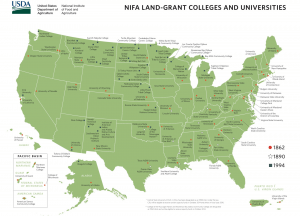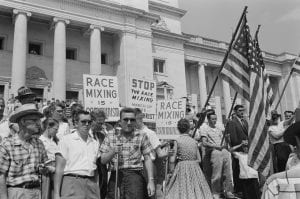In celebration of Black History Month, in addition to our weekly prompts to Get Outside, every Wednesday in February, we will be exploring the history of 4-H and Black History.
4-H and Black History
In 1902, what we now know as 4-H was started as a local agricultural after-school program in Ohio. Then in 1914 with the creation of the Cooperative Extension System (Smith-Lever Act), 4-H became a nation-wide program.
 The Cooperative Extension System is tied to land-grant universities, which were established in the middle of the Civil War by the Morrill Land Grant Act of 1862. Initially many land-grant universities only admitted white students. The Morrill Land Grant Act of 1890 required that each state show that race was not an admission criterion for land-grant universities. Rather than integrate existing institutions most states opened separate land-grant institution for black students. These new school now referred to as ‘1890 Institutions’ are among the 107 Historically Black Colleges and Universities in the United States (HBCUs).
The Cooperative Extension System is tied to land-grant universities, which were established in the middle of the Civil War by the Morrill Land Grant Act of 1862. Initially many land-grant universities only admitted white students. The Morrill Land Grant Act of 1890 required that each state show that race was not an admission criterion for land-grant universities. Rather than integrate existing institutions most states opened separate land-grant institution for black students. These new school now referred to as ‘1890 Institutions’ are among the 107 Historically Black Colleges and Universities in the United States (HBCUs).
When 4-H became a nation-wide program in 1914, it was tied to the already segregated Cooperative Extension System. Although 4-H programming for black and white youth was considered ‘separate but equal’ that was far from the truth. Funding for the Cooperative Extension System was tied to land-grant colleges and universities in which ‘1962 Institutions’ which had predominantly white students were (and in some cases still are) better funded than ‘1890 Institutions’ that had and still have predominately black students.

In the Supreme Court’s 1954 landmark decision ‘Brown v. Board of Education‘, Chief Justice Warren wrote that “in the field of public education the doctrine of ‘separate but equal’ has no place,” as segregated schools are “inherently unequal”. Much like schools, 4-H was unequal for black and white youth, but this ruling had very little, if any effect on the segregated nature of 4-H.
It was not until the the Civil Rights Act of 1964 that 4-H was forced to integrate. Not only did the Civil Rights Act of 1964 outlaw discrimination on the basis of race, color, religion, sex, or national origin, but it also made it illegal to use federal funds to conduct programs that did not actively pursue compliance. As 4-H receives federal funding, compliance was mandatory. Unfortunately, there was resistance to integration and some programs were shut down instead of integrating.
Here is an excerpt from an article that appeared in the Smithsonian Magazine in 2017 entitle The Complicated Growth of 4-H that further explores race in 4-H:
With the onset of World War II, the focus pivoted to patriotism. Many early urban 4-H programs—including those in Denver and Detroit—grew out of the victory garden movement. In June of 1946, hundreds of delegates from around the country arrived in Washington, D.C., for National 4-H Camp. At the foot of the Lincoln Memorial, the campers recited 4-H’s citizenship oath, promising to “never allow tyranny and injustice.” There was not a single black child among them.
At the time, African American 4-H clubs were run by a separate system of black agricultural colleges and extension agents, who earned significantly less than their white counterparts. 4-H remained segregated after 1954’s Brown v. Board of Education Supreme Court decision found segregated public schools unconstitutional. And when the Civil Rights Act of 1964 made segregated 4-H clubs and camps illegal, a number of the African American ones shut down. “We did not get integration, we got disintegration, a feeling that you would gradually disappear,” said Alberta Dishmon, a former Mississippi home-demonstration extension agent, in Thomas and Marilyn Wessel’s 1982 book, 4-H: An American Idea, 1900–1980.
 Equity, Diversity and Inclusion are now an important part of 4-H. The National 4-H Council states that, “access, equity, diversity, and inclusion are essential elements of 4-H’s goals related to positive youth development and organizational sustainability. For more than 20 years, 4-H has been intentional in building an organization and culture of belonging by actively inviting the contributions and participation of all youth.”
Equity, Diversity and Inclusion are now an important part of 4-H. The National 4-H Council states that, “access, equity, diversity, and inclusion are essential elements of 4-H’s goals related to positive youth development and organizational sustainability. For more than 20 years, 4-H has been intentional in building an organization and culture of belonging by actively inviting the contributions and participation of all youth.”
4-H has made much progress in equity, diversity and inclusion since its inception almost 120 years ago, although like many organization that were created and continue to exist in a society plagued by systemic racism there is still a long way to go before we reach our goals. All of us have a role to play as we strive to reach our goals. Click here for 4-H Resources concerning Diversity, Equity & Inclusion that you can use to support our efforts.
Join us next week as we continue to celebrate Black History Month and learn more about some of the early 4-H programming for black youth in 4-H.
Resources
4-H History – National 4-H Council
African American 4-H in Black History Month – National 4-H History Preservation Program
Brown v. Board of Education – History.com
The Complicated Growth of 4-H – Smithsonian Magazine
Diversity, Equity and Inclusion – New York State 4-H
Diversity, Equity, and Inclusion in 4-H – National 4-H Council
HBCU Listing – The Hundred-Seven
Land Grant and Universities: A Primer – 1890 Land-Grant Universities Foundation
Land-Grant But Unequal : State one-to-one match funding for 1890 Land-Grant Universities – Association of Public and Land-Grant Universities
What does it really mean to be a land-grant college? – University of California, Riverside